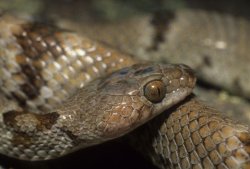Adult Mt. Kenya bush vipers are clad in a contrasting pattern of black and yellow.
It was back in the 1970s I acquired my first Mt. Kenya bush viper, Atheris desaixii. I hadn’t been looking for the taxon and I’m not even sure that I was aware of the existence of this viperine species until then.
Even then the acquisition was happenstance. I got a phone call one night from Hank Molt. It was back in those old those old days when Hank was “king of the herp rarities.”
“Dick. I know you like bush vipers and I’ve got one here that you just have to see.” It’s from Mt. Kenya and you’ve got to see it. C’mon up.” The fact that I was in Tampa and Hank was in Philadelphia was of small consequence. I hopped on the next northbound Delta and was soon in Philadelphia.
Hank met me at the airport and an hour later I was staring at one of the prettiest snakes I had until then seen. About 2 feet long, the ground color was charcoal and besides almost every dorsal and lateral scale bearing a tiny dot of butter yellow, the yellow was carried over into an intricate pattern.
When I asked Hank the price of the snake I was taken aback. Back in those days herps were usually quite affordable. This one teetered on the brink of being non-affordable. But I wanted the snake, Hank wanted to sell it, and after a bit of bargaining, it became mine. Ahhhh. Those were the good old days!
Continue reading ” Mt. Kenya Bush Viper” …read more
Read more here: King Snake
No products found.





















